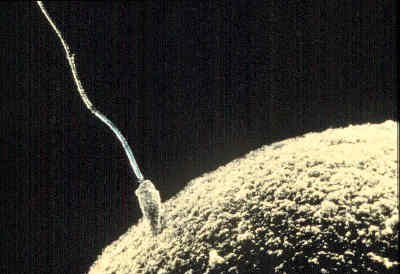Ovum
|
WikiDoc Resources for Ovum |
|
Articles |
|---|
|
Media |
|
Evidence Based Medicine |
|
Clinical Trials |
|
Ongoing Trials on Ovum at Clinical Trials.gov Clinical Trials on Ovum at Google
|
|
Guidelines / Policies / Govt |
|
US National Guidelines Clearinghouse on Ovum
|
|
Books |
|
News |
|
Commentary |
|
Definitions |
|
Patient Resources / Community |
|
Directions to Hospitals Treating Ovum Risk calculators and risk factors for Ovum
|
|
Healthcare Provider Resources |
|
Continuing Medical Education (CME) |
|
International |
|
|
|
Business |
|
Experimental / Informatics |
Overview


An ovum (plural ova) is a haploid female reproductive cell or gamete. The word is derived from Latin, meaning egg or egg cell. Both animals and embryophytes have ova. The term ovule is used for the young ovum of an animal, as well as the plant structure that carries the female gametophyte and egg cell and develops into a seed after fertilization. In some plants, such as algae, it is also called oosphere.
Material contribution to offspring
The egg is the sole provider of such endosymbiotic organelles, including mitochondria within the cytoplasm. These cannot be produced with nuclear DNA alone and must be manufactured from DNA within existing organelles of their type (such as mitochondrial DNA) — this is important in Human mitochondrial genetics and can be used to trace maternal and paternal ancestry, especially as plants contain chloroplasts as well. Sperm are often too small to contribute anything physical except DNA and its own mitochondria gets destroyed by the egg.
Ova production
In higher animals, ova are produced by female gonads (sexual glands) called ovaries and all of them are present at birth in mammals, and mature via oogenesis.
Human and mammal ova

In the viviparous animals (which include humans and all other placental mammals), the ovum is fertilized inside the female body, and the embryo then develops inside the uterus, receiving nutrition directly from the mother. The ovum is the largest cell in the human body, typically visible to the naked eye without the aid of a microscope or other magnification device. The human ovum measures on average, 145 µm in diameter.
Protist and plant ova
In protists, fungi and many plants, such as bryophytes, ferns, and gymnosperms, ova are produced inside archegonia. Since the archegonium is a haploid structure, egg cells are produced via mitosis. The typical bryophyte archegonium consists of a long neck with a wider base containing the egg cell. Upon maturation, the neck opens to allow sperm cells to swim into the archegonium and fertilize the egg. The resulting zygote then gives rise to an embryo, which will grow out of the archegonium as a sporeling (young sporophyte).
In the flowering plants, the female gametophyte, which usually gives rise to the archegonium, has been reduced to just eight cells referred to as the embryo sac inside the ovule. The gametophyte cell closest to the micropyle opening of the embryo sac develops into the egg cell. Upon pollination, a pollen tube delivers sperm into the embryo sac and one sperm nucleus fuses with the egg nucleus. The resulting zygote develops into an embryo inside the ovule. The ovule in turn develops into a seed and in many cases the plant ovary develops into a fruit to facilitate the dispersal of the seeds. Upon germination, the embryo grows into a seedling.
Ova development in oviparous animals
In the oviparous animals (all birds, most fishes, amphibians and reptiles) the ova develop protective layers and pass through the oviduct to the outside of the body. They are fertilized by male sperm either inside the female body (as in birds), or outside (as in many fishes). After fertilization, an embryo develops, nourished by nutrients contained in the egg. It then hatches from the egg, outside the mother's body. See egg (biology) for a discussion of eggs of oviparous animals.
The egg cell's cytoplasm and mitochondria (and chloroplasts in plants) are the sole means of the egg being able to reproduce by mitosis and eventually form a blastocyst after fertilization.
Ovoviviparity
There is an intermediate form, the ovoviviparous animals: the embryo develops within and is nourished by an egg as in the oviparous case, but then it hatches inside the mother's body shortly before birth, or just after the egg leaves the mother's body. Some fish, reptiles and many invertebrates use this technique.
See also
- Egg (biology)
- Fertilisation
- Insemination
- Menstrual cycle
- Ovulation
- Pollination
- Pregnancy
- Respiratory burst
- Sperm
- Zygote
- Male egg
External links
- The Ovarian Kaleidoscope Database description of 1800 genes involved in ovarian functions